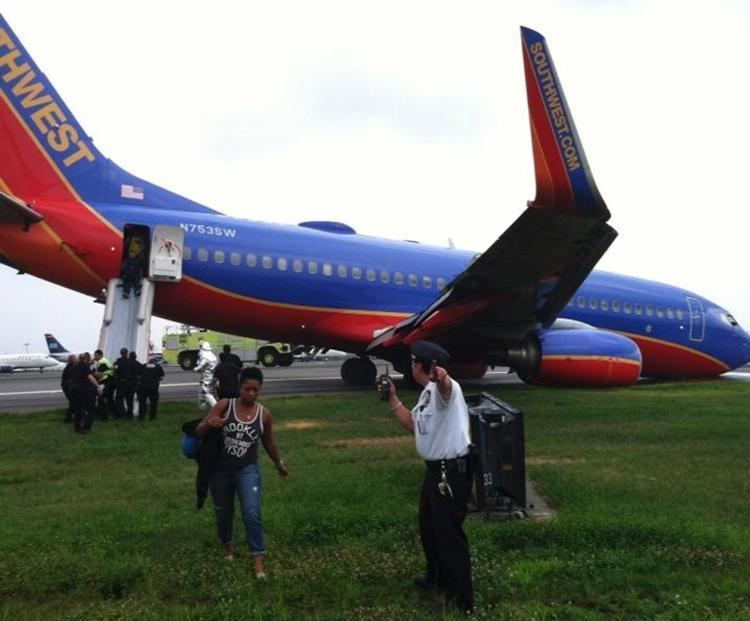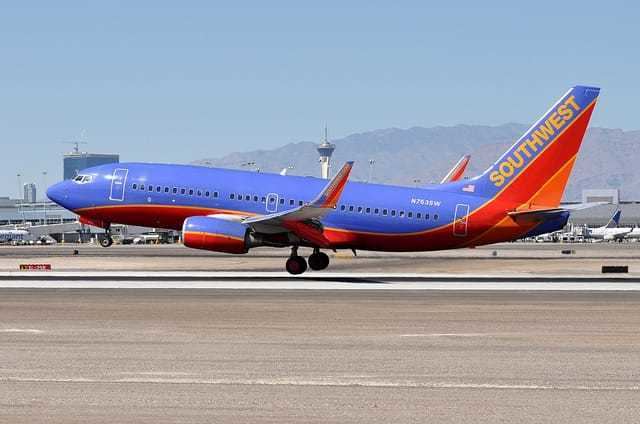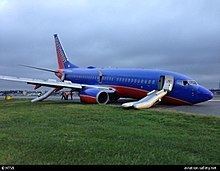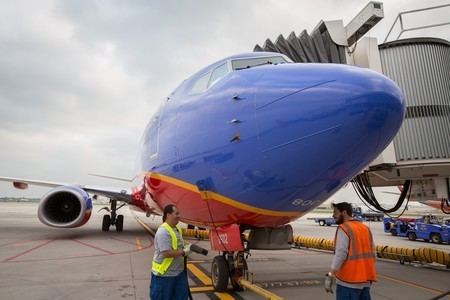Crew 5 Survivors 150 (all) Number of deaths 0 Survivor 150 (all) | Passengers 145 Fatalities 0 Date 22 July 2013 Injuries (nonfatal) 9 | |
 | ||
Summary Landing gear collapse due to pilot error Similar Southwest Airlines Flight 1455, Southwest Airlines Flight 812, Southwest Airlines Flight 1248, 2013 Ethiopian Air Force, Southwest Airlines Flight 2294 | ||
Southwest airlines flight 345 in crash full
Southwest Airlines Flight 345 was a scheduled flight from Nashville International Airport to New York City's LaGuardia Airport on July 22, 2013. The Boeing 737 suffered a collapse of its front landing gear while landing at LaGuardia Airport, injuring 9 people on board. The aircraft, which was worth an estimated $15.5 million at the time, was written off as a total loss and scrapped as a result of the accident.
Contents
- Southwest airlines flight 345 in crash full
- Southwest airlines flight 345 crash atc with subtitles
- Aircraft and flight crew
- Incident
- Investigation
- Aftermath
- References

Southwest airlines flight 345 crash atc with subtitles
Aircraft and flight crew
The aircraft was a 13-year-old Boeing 737-700, registration number N753SW, owned and operated by Southwest Airlines.

Flight 345's captain had flown for Southwest Airlines for nearly 13 years, six years in the rank as captain. At the time of the accident, she had a total of 12,000 hours of flight time, including 2,600 flight hours as captain of a Boeing 737.

The first officer had 20 years of prior experience in the United States Air Force and had been hired by Southwest Airlines a year and a half before the accident.
Incident
The aircraft landed on runway 4 with its nose landing gear touching down prior to the main landing gear. The aircraft's nose gear collapsed upward into the body of the aircraft, causing substantial damage to the avionics electronics bay in the fuselage. The aircraft slid 2,175 feet (663 m) on its nose along the runway, arresting off to the right of the runway pavement. The plane came to a stop halfway down the runway after skidding on its nose in a sea of sparks.

As a result of the crash, the two-runway airport was closed until its rescue assets were available again. Two hours later, the airport's other runway reopened for traffic. The airport cleared and inspected the affected runway, and removed the aircraft in time for the earliest next day departures. Nine occupants were treated for minor injuries, all sustained during evacuation, six of whom were taken to local hospitals.
Investigation
On July 23, 2013, the National Transportation Safety Board opened an accident investigation.
On July 26, 2013, the NTSB issued a press release disclosing its initial findings, which included:

No mechanical malfunctions were found, but the nose landing gear collapsed due to stress overload. The NTSB's investigation became focused on the behavior of the flight crew during Flight 345's approach into LaGuardia Airport. The NTSB discovered that Flight 345's captain had been the subject of multiple complaints by first officers who had flown with her. Southwest's flight operations manual requires its pilots to abort a landing if the plane is not properly configured by the time it descends to 1,000 feet. Analyzing flight recorder data, the NTSB determined that the captain had changed the airplane's flaps from 30 degrees to 40 degrees at an altitude of only 500 feet. At 100 to 200 feet, the captain observed that the plane was still above the glide slope, and ordered the first officer to "get down" instead of aborting the landing. At an altitude of only 27 feet and 3 seconds from touching down, the captain took control of the aircraft from the first officer. The plane was descending at 960 feet per minute in a nose-down position when its nose wheel struck the runway.
The NTSB ultimately concluded that the crash was due to pilot error. Specifically, the NTSB faulted the captain for failing to take control of the aircraft or abort the landing earlier, noting that the captain had warnings at 500 feet (due to the flaps misconfiguration) and at 100 to 200 feet (when the captain observed the plane was above the glide scope) and could have aborted the landing at that time. The NTSB determined that the captain's failure to take control until the plane had descended to only 27 feet "did not allow her adequate time to correct the airplane's deteriorating energy state and prevent the nose landing gear from striking the runway."
Aftermath
On October 2, 2013, Southwest Airlines announced that it had fired Flight 345's captain. The airline also announced that it was requiring Flight 345's first officer to undergo additional training. Neither pilot was publicly identified by the airline.
The Boeing 737 involved in the accident, worth an estimated $15.5 million at the time, was found to be too extensively damaged to be repaired and was written off as a total loss. The aircraft was ultimately removed from LaGuardia Airport via barge to the Port of Albany (New York) in November 2013, where the airframe was broken up by a salvage dealer at the Port of Albany in March 2014, with some parts trucked to Owego for final destruction.
